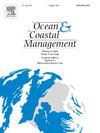马斯克林群岛板鳃科生物多样性与保护:政策实施与保护策略
IF 5.4
2区 环境科学与生态学
Q1 OCEANOGRAPHY
引用次数: 0
摘要
尽管马斯卡林群岛被认为是印度洋上主要的海洋生物多样性热点之一,但居住在这些水域的板鳃纲物种仍然知之甚少。至关重要的是填补这些信息空白,以便更好地为它们的保护和管理行动提供信息。马斯克林群岛伊拉斯莫布兰奇天文台(MAEO)计划建立了一个伊拉斯莫布兰奇观测网络,涉及跨越毛里求斯、毛里求斯和罗德里格斯群岛的几个海洋用户团体。此外,社交媒体上的活跃搜索有助于增加elasmobranch的观察。同时,进行了远程水下视频系统(有饵和无饵)和水下视觉普查。从2021年到2024年,据报道有1615次目击,其中包括两个在卢旺达新记录的物种,一个在毛里求斯,还有一个是科学上的新物种。在Mascarenes已知的67种elasmobranch中,有32种(47.8%)在本研究中被记录。根据世界自然保护联盟濒危物种红色名录,在67个物种中,有42个(62.7%)被列为濒危物种。对卢旺达和毛里求斯现行立法的审查表明,虽然存在一些保护弹力枝的条例,但这些条例往往不为人了解或执行不力。加强和执行渔业法规至关重要。此外,提高公众意识和教育是加强对蝗虫保护的关键。考虑到这一点,在推动MAEO计划和吸引整个地区的公众方面做出了重大努力。经过3年的研究,这些发现为马斯卡林的板鳃目保护措施提供了有用的信息。同时,研究结果强调了对该地区这些物种进行进一步研究的必要性。本文章由计算机程序翻译,如有差异,请以英文原文为准。
Biodiversity and conservation of elasmobranchs in the Mascarene Islands: Policy implementation and protection strategies
Although the Mascarene Archipelago is considered one of the main marine biodiversity hotspots in the Indian Ocean, the elasmobranch species residing in these waters remain poorly understood. It is crucial to fill these information gaps to better inform actions for their conservation and management. The Mascarene Archipelago Elasmobranch Observatory (MAEO) program established an elasmobranch sighting network involving several ocean user groups across Réunion, Mauritius and Rodrigues islands. Additionally, active searches on social media contributed to an increase in elasmobranch observations. In parallel, remote underwater video systems (both baited and unbaited) and underwater visual census surveys were performed. From 2021 to 2024, 1615 elasmobranch sightings were reported, including two species newly recorded for Réunion, one for Mauritius, and one species new to science. Of the 67 elasmobranch species known in the Mascarenes (updated list from this study), 32 species (47.8 %) were recorded in this study. Among the total 67 species, 42 (62.7 %) are classified as threatened with extinction according to the IUCN Red List of Threatened Species. A review of current legislation in Réunion and Mauritius indicates that while some regulations exist to protect elasmobranchs, they are often poorly understood or inadequately enforced. Strengthening and enforcing fishing regulations is crucial. Moreover, raising public awareness and education is key to enhancing elasmobranch protection. Considering this, significant efforts have been made to promote the MAEO program and engage the public across the region. After three years, the findings provide useful information to inform effective conservation measures for elasmobranchs in the Mascarenes. Simultaneously, the results underscore the need for further research on these species in this region.
求助全文
通过发布文献求助,成功后即可免费获取论文全文。
去求助
来源期刊

Ocean & Coastal Management
环境科学-海洋学
CiteScore
8.50
自引率
15.20%
发文量
321
审稿时长
60 days
期刊介绍:
Ocean & Coastal Management is the leading international journal dedicated to the study of all aspects of ocean and coastal management from the global to local levels.
We publish rigorously peer-reviewed manuscripts from all disciplines, and inter-/trans-disciplinary and co-designed research, but all submissions must make clear the relevance to management and/or governance issues relevant to the sustainable development and conservation of oceans and coasts.
Comparative studies (from sub-national to trans-national cases, and other management / policy arenas) are encouraged, as are studies that critically assess current management practices and governance approaches. Submissions involving robust analysis, development of theory, and improvement of management practice are especially welcome.
 求助内容:
求助内容: 应助结果提醒方式:
应助结果提醒方式:


